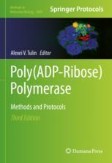Search
Search Results
-
Metabolic changes of the red marine alga Gracilariopsis tenuifrons elicited by high PAR in laboratory
Although known, the photosynthetically active radiation (PAR) triggers responses that still deserve attention. Then, our study aims to investigate...

-
Quantitative Analysis of Nuclear Poly(ADP-Ribose) Dynamics in Response to Laser-Induced DNA Damage
Poly(ADP-ribose) (PAR), catalyzed by members of the poly(ADP-ribose) polymerase family of enzymes, is a posttranslational modification with a...
-
The Metabolism of Thermophilic Hydrolytic Bacterium Thauera hydrothermalis Strain par-f-2 Isolated from the West Siberian Subsurface Biosphere
AbstractA novel moderately thermophilic, organotrophic bacterium, strain Par-f-2, was isolated from a sample of hot water emerging from a 2775 m-deep...

-
Impacts of ultraviolet and photosynthetically active radiations on photosynthetic efficiency and antioxidant systems of the cyanobacterium Spirulina subsalsa HKAR-19
This study summarizes the response of cyanobacterium Spirulina subsalsa HKAR-19 under simulated light conditions of photosynthetically active...

-
Poly(ADP-Ribose) Polymerases 1 and 2: Classical Functions and Interaction with New Histone Poly(ADP-Ribosyl)ation Factor HPF1
AbstractPoly(ADP-ribose) (PAR) is a negatively charged polymer, linear or branched, that consists of ADP-ribose monomers. PAR is synthesized by...

-
Physiological response of mature red spruce trees to partial and complete sapwood severing
Drought frequency and severity are projected to increase in many regions of the world, yet it remains unclear how mesic forest trees will respond to...

-
Satellite-based estimates of photosynthetically active radiation for tropical ecosystems in Ghana—West Africa
Photosynthetically active radiation (PAR; 0.40–0.70 μm) is a key driver in ecosystem biochemical processes, and thus a critical factor in agriculture...

-
A comparative study on the effects of strong light stress on the photosynthetic characteristics of the shade plant Camellia petelotii (Merr.) Sealy
Camellia petelotii (Merr.) Sealy is a rare medicinal and edible plant in China whose wild species have a narrow distribution range and poor...

-
Radiation Interception and Radiation Use Efficiency Response to Intraspecific Competition in Barley (Hordeum vulgare) Cultivars
Light extinction coefficient (K PAR ) and radiation use efficiency (RUE) may be influenced by environmental and genetic conditions. In order to study...

-
Crocetin antagonizes parthanatos in ischemic stroke via inhibiting NOX2 and preserving mitochondrial hexokinase-I
Parthanatos is one of the major pathways of programmed cell death in ischemic stroke characterized by DNA damage, poly (ADP-ribose) polymerases...

-
Elevated CO2 concentrations increase carbon sinks in paddy fields: an in situ four-year field experiment
Rice paddies play a crucial role in the global carbon cycle by sequestering or releasing carbon dioxide (CO 2 ) into the atmosphere. However, the...

-
Continuous Lighting Increases Yield and Nutritional Value and Decreases Nitrate Content in Brassicaceae Microgreens
AbstractMicrogreens of four species of the family Brassicaceae (broccoli, mizuna, radish, and arugula) were grown under 16- and/or 24-h photoperiod...

-
Einfluss der Verschmutzung von Reflexionsfolien auf ihr Reflexionsverhalten
The objective of the present work was to study the effects of contamination on the reflective properties of groundcovers used for enhancing fruit...

-
Responses of Trifolium repens L. root structure and function to shading and phosphorus shortage: limits to adaptative plasticity during establishment?
Shading and low soil phosphorus availability may limit root growth of forage species in humid-temperate silvopastoral systems. However, plants are...

-
Tree growth and wheat productivity are affected by pollarding Faidherbia albida in semi-arid Ethiopia
Faidherbia albida tree is known for its positive influence on most crops due to reverse leafing phenology. This study aimed at investigating the...

-
Effect of tree form on wheat yield via changing microenvironment in almond–wheat intercrop**
Agroforestry systems are widely used all over the world, especially in southern **njiang, China, because of their multiple ecosystem functioning and...

-
Chromosome-length genome assemblies and cytogenomic analyses of pangolins reveal remarkable chromosome counts and plasticity
We report the first chromosome-length genome assemblies for three species in the mammalian order Pholidota: the white-bellied, Chinese, and Sunda...

-
Residual, direct and interaction effect of nutrient management on growth, yield, quality, and economics of fodder maize and soil nutrient balance under grain amaranth (Amaranthus hypochondriacus L.)– fodder maize [Zea mays (L.)] sequence in Inceptisols of Western India
Aiming to investigate the residual, direct and interaction effect of nutrient management on growth, yield, quality, nutrient uptake, monetary...

-
Can Paddy-Compost Eliminate N Fertilization for Climate-Smart Sugarcane?
Paddy straw burning and its consequences on the ecosystem forced to reuse of this paddy compost (PC) in long-standing sugarcane crops, which also...

-
Influence of canopy architecture on photosynthetic parameters and fruit quality of mango in tropical region of India
Canopy architecture is one of the most critical components influencing photoassimilation, yield and quality of fruit crops; thus, it is logical to...

